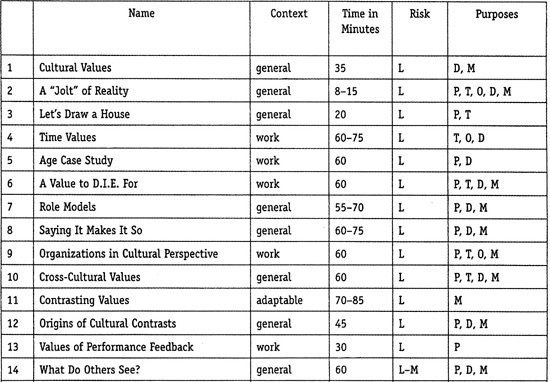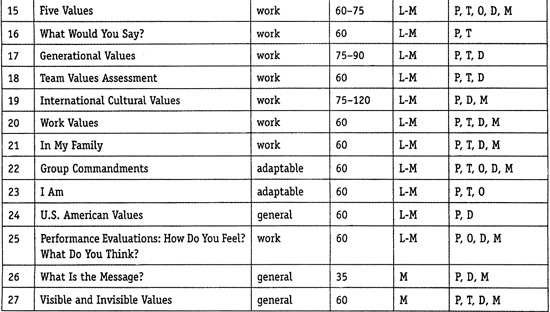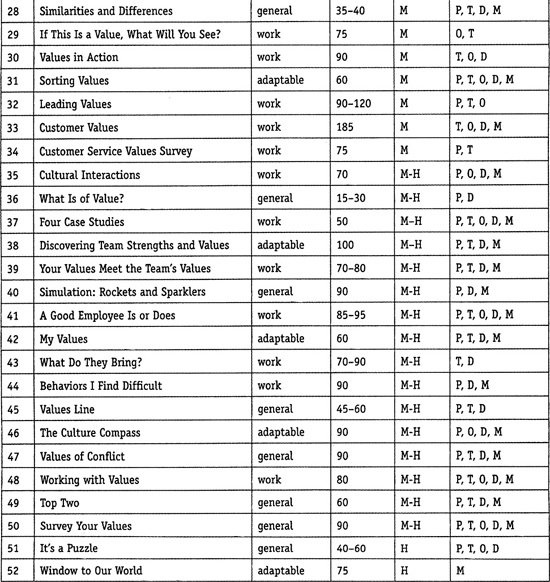52 Activities
for
Exploring
Values
Differences
Permissions
Grateful acknowledgment is made to the authors and publishers who granted permission to include adapted versions of their activities or to use research materials to devise new activities.
Milton J. Bennett and Janet M. Bennett, Intercultural Communication Institute, Portland, Oregon
Pierre Casse, Training for the Cross-Cultural Mind: A Handout for Cross-Cultural Trainers and Consultants.
Executive Diversity Services, Seattle, Washington, for numerous activities and/or handouts.
Lee Gardenswartz and Anita Rowe, Diverse Teams at Work: Capitalizing on the Power of Diversity.
Brian P. Hall, Personal Workbook: Understanding and Working with Values.
Brian P. Hall and Martin L. W. Hall, Understanding and Working with Values.
Intercultural Press for permission to use material from the following:
Paula Chu, in Experiential Activities for Intercultural Learning
Donna Goldstein, in Experiential Activities for Intercultural Learning
Daniel J. Hess, The Whole World Guide to Culture Learning.
Robert L. Kohls and John Knight, Developing Intercultural Awareness: A Cross-Cultural Training Handbook, 2d edition.
Paul Pedersen, in Intercultural Sourcebook: Cross-Cultural Training Methods, Vol. 2.
Kurt W. Russo, ed. Florence Kluckhohns Value Orientations Survey in Finding the Middle Ground: Insights and Applications of the Value Orientations Method.
Craig Storti, Figuring Foreigners Out: A Practical Guide.
Carol Wolf, in Experiential Activities for Intercultural Learning.
Terrell Jones, The Pennsylvania State University.
Andre Laurent, Reinventing Management at the Cross-Roads of Culture, The Summer Institute for Intercultural Communication.
Anita Rowe, Understanding Diversity Blind Spots in the Performance Review.
Kristine Sullivan, presentation on Dr. Bernard Haldanes Dependable Strengths Process, Seattle University, Seattle, Washington.
Sivasailam Thiagarajan, activities presented at The Summer Institute for Intercultural Communication.
Harry C. Triandis, from research for Culture and Social Behavior.
Van Hutton, from a presentation on values presented at Seattle University, 1998.
Jaime Wurzel, 1993.
Ron Zemke, Claire Raines, and Bob Filipczak, Generations at Work: Managing the Clash of Veterans, Boomers, Xers, and Nexters. Performance Research Associates, Inc., AMACOM, a division of the American Management Association.
52 Activities
for
Exploring
Values
Differences
Donna M. Stringer and Patricia A. Cassiday
First published by Intercultural Press. For information contact:
Intercultural Press, Inc. | Nicholas Brealey Publishing |
a division of | 3-5 Spafield Street |
Nicholas Brealey Publishing | Clerkenwell |
20 Park Plaza, Suite 1115A | London, EC1R 4QB, UK |
Boston, MA 02116, USA | Tel: +44-(0) 207-239-0360 |
Tel: (+)617-523-3801 | Fax: +44-(0) 307-239-0370 |
Fax: (+) 617-523-3708 | www.nicholasbrealey.com |
2003 by Donna M. Stringer and Patricia A. Cassiday
All rights reserved. The materials presented in this volume are reproducible and may be used or adapted for use in educational and training settings. Any other publication or distribution of the materials is prohibited without the written permission of Intercultural Press.
Printed in the United States of America
16 15 14 13 12 3 4 5 6 7
Library of Congress Cataloging-in-Publication Data
Stringer, Donna M.
52 activities for exploring values differences/Donna M. Stringer and Patricia A. Cassiday.
p. cm.
Includes bibliographical references.
1-877864-96-X
1. Cross-cultural orientationActivity programs. 2. EthnopsychologyStudy and teachingActivity programs I. Title: Fifty-two activities for exploring values differences. II. Cassiday, Patricia A. III. Title.
GN345.65.S77 2003
Acknowledgments
This book would not have been possible without the foundation work on values by many of our colleagues and predecessors, for which we are enormously grateful. We particularly want to acknowledge the principals of Executive Diversity Services, Inc. in Seattle, Washington (Andy Reynolds, Elmer Dixon, and Linda Taylor), who have developed many of these activities over the past two decades. Faculty at The Summer Institute for Intercultural Communication in Portland, Oregon, have contributed substantially to our thinking and skills as trainers and educators, and the rich resources of books offered by Intercultural Press have been our foundation. We also thank the editorial and production team at Intercultural Press for their expertise and careful editing. We owe our enthusiasm for, and confidence in, an experiential learning approach to Sivasailam Thiagarajan, Thiagi, to whom we are grateful. Thiagi is a master of the experiential approach, and he always encourages his students to find their own answers to the question.
We hope this book is useful to you. Please modify the activities to meet the needs of your audienceas we have through the years.
The authors have made every effort to cite and acknowledge all those from whom research, lecture material, or activities have been adapted.
Classification of Activities



Risk: L=Low, M=Medium, H=High
Purposes: P = Personal, T = Team, O = Organizational,
D = U.S. Diversity, M = Multinational
Introduction
Bend, flex or break the rules but never violate the values.
King County Library System, 1997
Values are like fingerprints. Nobodys are the same, but you leave em all over everything you do.
Elvis Presley
Values are deeply held beliefs that determine what is good, right, and normal and what is bad, wrong, and abnormal among members of a cultural group. Values, then, prescribe which ways of acting and being are perceived by a cultural group as better than others. Because of this and because values vary widely among cultural groups, they mayand often docause cross-cultural misunderstandings and conflict.
Values clashes occur frequently when people from different cultures interact. Even more important, differing cultural values exist not only country to country but also within corporations, organizations, universities, towns, ethnic groups, neighborhoods, and so on. In other words, we live with values differences every day and may be unaware when a misunderstanding or problem we encounter is based on such fundamental differences.
Consequently, most educators, trainers, and facilitators who explore intercultural and cross-cultural issues incorporate values into their planning. In designing our own academic classes and corporate workshops over the past three decades, we have often created our own values activities or modified those of others to shape an experience that fits a particular audience. In adapting or creating values activities, we have relied on the work of several well-known approaches to values. Well take a brief look at these next because they form the framework on which ours and others values activities are based.
Next page









